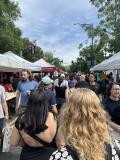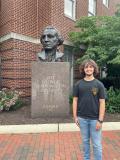Sunday, June 2, 2024
By:
This week, I was lost in the woods.
Starting a new internship in a new city can be daunting. You need to acclimate to your environment and job, all while trying to make the most of your time in a new place and make friends. It can be exhausting, but it is also exhilarating.
For those of you who don't know me, my name is Kai, and I'm a rising junior at Princeton University where I'm studying History of Science and Applied Math (with a focus in physics/astrophysics). I am also the AIP History/Niels Bohr Archives and Library Program intern, and at my internship, there seems to be an endless stream of information that I need to orient myself to. With every step I take, there is a new historical figure, event, or debate popping up that I need to learn about. However, while vast and perhaps scary at times – as forests can be – it is also sublime.
Over the past week, I have read countless articles on physicists of minority identities that often get lost in the traditional narratives that surround the history of physics and other natural sciences. Although we might typically hear of figures such as Albert Einstein, Isaac Newton, Richard Feynman, and Galileo, we rarely hear about those who fall outside the categories of White and male. In turn, because of this lack of visibility, these vital players in physics’ development get erased from the commonly told story. Yet, the history of physics is much richer than many believe it to be, as I realized much more this past week. This realization is exactly what makes history and all its complex workings so alluring. Through history research, I can get lost in all the information, recognize the beauty in its entanglements, and keep treading on, eventually making sense of the past’s complexities.
Mind you, when I say that I was lost in the woods, I don’t mean this solely in the metaphorical sense. I also (briefly) got physically lost in the woods. You might look at me and ask, “Kai, you are in a city. What forests could there possibly be?” In return, I would look at you and say, “That’s exactly what I thought.”
As a person who always wants to take full advantage of whichever situation I’m in, I decided to make the most of my first weekend. Starting bright and early on Saturday, I left for Georgetown to visit Tudor Place which had an exhibition on the lives of enslaved workers on the estate of the Peter family (related to Martha Washington) in the 1800s and the enslaved people’s descendants. Moving and thought-provoking, Tudor Place illuminated these hidden stories, forcing goers to recognize the complete, un-whitewashed stories that we frequently do not hear. With still half a day left, I decided to go to Dumbarton Oaks – an old mansion and gardens that houses Byzantine and Pre-Columbian art. The thing to realize about Dumbarton Oaks is that it has renowned gardens, so the tickets were all sold out. I still wanted to see nature though, and conveniently, there was a park right next to the estate. As I went deeper and deeper into the park, it became a forest. Dirt trails followed babbling streams, and sunlight gleamed emerald through the trees’ foliage.
Despite my countless experiences hiking and (correctly) following maps, I somehow managed to stray off the beaten track. The path became increasingly overgrown, and I thought of turning back. I had no clue where I was. Yet, the beauty of the park made me continue onward. I wanted to explore; I wanted to get lost. Only by doing so could I see things I hadn’t seen before. By taking a deep breath, taking in the beauty around me instead of panicking, I knew that I would eventually make my way out of the forest. And I did.
With this mentality and trying to make the most out of every situation I’m in, getting lost in the woods can be a good thing if you let yourself be confused. Use your confusion as a conduit for exploration and interrogation, and always lean into the natural beauty around you.
P.S. If any future intern is reading this and wants ideas as to what to do, I’ll try my best to put my recommendations at the end of each post.
Recommended Activities: Heurich House Museum, Tudor Place, Dumbarton Oaks and the park surrounding it, the National Cathedral, DuPont Circle Market, and the National Museum of Women in the Arts.
Kai Hostetter-Habib





